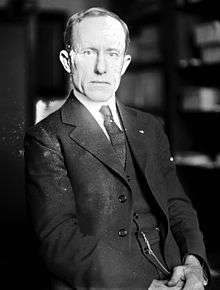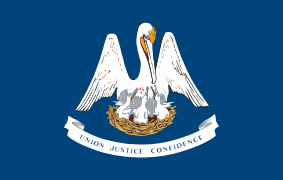John N. Sandlin
| John Nicholas Sandlin, Sr. | |
|---|---|
 | |
| Member of the U.S. House of Representatives from Louisiana's 4th district | |
|
In office March 4, 1921 – January 3, 1937 | |
| Preceded by | John T. Watkins |
| Succeeded by | Thomas Overton Brooks |
| Judge of Louisiana's 2nd Judicial District Court | |
|
In office March 4, 1911 – December 4, 1920 | |
| Preceded by | Richard Cleveland Drew |
| Succeeded by | Robert Roberts, Jr. |
| District Attorney of Louisiana's 2nd Judicial District | |
|
In office December 8, 1904 – March 4, 1911 | |
| Preceded by | Charles E. McDonald |
| Succeeded by | Thomas W. Robertson |
| Personal details | |
| Born |
February 24, 1872 |
| Died | December 25, 1957 (aged 85) |
| Resting place | Minden Cemetery |
| Political party | Democratic |
| Relations | McIntyre H. Sandlin (brother) |
| Alma mater | Minden Normal School and Business College |
John Nicholas Sandlin, Sr. (February 24, 1872 – December 25, 1957), of Minden, Louisiana, represented Louisiana's 4th congressional district in the United States House of Representatives from 1921 to 1937.
In 1936, rather than seeking a ninth term in the House, Sandlin, upon the request of U.S. President Franklin D. Roosevelt, contested an open seat in the U.S. Senate. He lost the pivotal Democratic nomination to Allen J. Ellender of Houma in Terrebonne Parish in South Louisiana. A confidant of the late Huey Pierce Long, Jr., Ellender received 364,931 ballots (68 percent) to Sandlin's 167,471 votes (31.2 percent). There was no Republican candidate, and Ellender was sworn into the first of what would become six consecutive senatorial terms.
Background
Sandlin was born in the McIntyre community west of Minden, the younger of two sons to Nicholas J. Sandlin (died 1890), originally from North Carolina, and the former Irene McIntyre (1840-1922), a Louisiana native. Nicholas Sandlin served in the Army of Northern Virginia under Generals Robert E. Lee and Stonewall Jackson and was severely wounded in the American Civil War. In Louisiana, Nicholas Sandlin was active in the overthrow of the Carpetbagger government. He was district attorney of a tract of land stretching from the Red to the Ouachita rivers. Years later, he represented Webster Parish in the Louisiana House of Representatives. In 1893, U.S. President Grover Cleveland named him postmaster at Minden. The former Nicholas J. Sandlin Camp near Minden was named in his honor by the organization, Sons of Confederate Veterans."[1]
John Sandlin's older brother, McIntyre H. Sandlin, was a mayor of Minden, a state representative like his father, and a long-term tax assessor of Webster Parish.[1]
Sandlin was educated in public schools and attended the former Minden Normal School and Business College, the forerunner to Minden High School. He privately studied law and was admitted to the bar in 1896, when he began his legal practice in Minden. He was immediately elected to the Minden City Council. Like his father, he was a Minden postmaster, From 1904 to 1910, he was district attorney for the Second Judicial District (since 26th District). He was judge of the same district from 1910 to 1920. He was a member of the Methodist Church, the Knights of Pythias, and the Masonic lodge.[2]
In 1917, Judge Sandlin presided over a sensational ax-murder case in which the young district attorndey, Harmon Caldwell Drew, led the prosecution against several African American and white suspects charged with the Christmas Day 1916 murder of the John Nelson Reeves family in the rural Grove community north of Minden.[3]
In 1916, Sandlin was a delegate to the Democratic National Convention, which met in St. Louis, Missouri, to renominate U.S. President Woodrow Wilson of New Jersey and Vice President Thomas R. Marshall of Indiana, for their second terms in office. In 1944, he was a presidential elector for the fourth term of Franklin Roosevelt.[2]
Congressional tenure
Sandlin was first elected to Congress in 1920, when he denied renomination to the incumbent, John Thomas Watkins, also of Minden. In 1931, Sandlin proposed the "cotton holiday", under which the United States Department of Agriculture advanced loans of nearly double the price of cotton to southern farmers to prevent massive bankruptcies. Some eleven million dollars went into the hands of Louisiana farmers under Sandlin's measure.[4]
In 1933, United States Postmaster General James A. Farley of New York, also the chairman of the Democratic National Committee, came to Shreveport, where he lavised high praise on Representative Sandlin. Farley said that "no man in Congress has worked harder [than Sandlin] to assist us in bringing this nation out of chaos," a reference to the New Deal attempt to combat the Great Depression. "Anything we can do for him and his district, we will be glad to do so," Farley added. At the rally, Sandlin told Farley that Louisiana stood "100 percent behind" President Franklin Roosevelt.[5]
Organized labor endorsed Sandlin's last reelection, as it developed, in 1934 saying that the lawmaker was "absolutely dependable" in meeting the needs of "the common people."[6] Marion S. Hollenshead, a member of the Louisiana State Senate from Haynesville in Claiborne Parish, challenged Sandlin for re-nomination but soon withdrew because of ill health.[7] Sandlin then won by a seven-to-one margin over his remaining opponent, Dr. J. H. Cannon of Shreveport.[8] Hollenshead subsequently left the Senate two years later after only one term in office.[9]
Sandlin was a member of the commission which authorized the Jefferson National Expansion Memorial in St. Louis, Missouri, in recognition of the Louisiana Purchase of 1803.[10]
Roosevelt thereafter urged Sandlin to challenge the reelection of U.S. Senator Huey Long. However, before the scheduled election in 1936 could occur, Long was assassinated in 1935. Pro-Long supporters, who coalesced behind Allen Ellender, started a false allegation that Sandlin had been involved in the assassination of Long.[11]
During part of Sandlin's congressional tenure, his chief aide was J. Frank Colbert, a former member of the Louisiana House of Representatives and the mayor of Minden from 1944 to 1946. Upon leaving Washington, D.C., in 1937, Sandlin resumed his law practice in Minden.
Personal life
Sandlin was a Methodist, a Freemason, and a member of Woodmen of the World.
Sandlin married the former Ruth Reams (February 3, 1878 – March 28, 1911), and they had a son, John N. Sandlin, Jr. (May 3, 1900 – April 19, 1960), who was a staff sergeant in both World War I and World War II. They lost an infant daughter, also named Ruth, who lived only from March 19 to April 10, 1911. Ruth R. Sandlin died from complications from childbirth thirteen days before the death of their daughter.[12]
In 1913, Sandlin wed Mrs. Emma Lou Palmer Crichton (pronounced CRAY TUHN), a member of a prominent Minden family.
In 1951, Sandlin had a heart attack in Oxford, Mississippi, where he had taken his wife for treatment of an eye illness.[13] He recovered in Shreveport and then Minden.
Sandlin died at the age of eighty-five in the former Minden Sanitarium on Christmas Day 1957. He had been residing in Minden with his son following the death earlier of his wife.[2] He is interred in the old section of the Minden Cemetery. His grave marker reads, "To Know Him Was to Love Him."
References
- 1 2 "John N. Sandlin, member of Congress". usgwarchives.net. Retrieved November 15, 2013.
- 1 2 3 "Final Rites Held for J. N. Sandlin Here Friday", Minden Press, December 30, 1957, p. 1
- ↑ Marilyn Miller, Sons of Darkness Sons of Light (Many, Louisiana: Sweet Dreams Publishing Co., 2000), p. 188, ISBN 1-893693-09-0
- ↑ "John N. Sandlin, Our Friend" (editorial), Minden Herald, January 3, 1936, p. 1
- ↑ "Democratic Chairman Pays John N. Sandlin High Tribute," Minden Herald, October 20, 1933, p. 1
- ↑ "Labor Board Endorses Sandlin's Reelection: Says He Is Absolutely Dependable, Ready to Work, and Always for the Ccmmon People", Minden Herald, July 6, 1934, p. 1
- ↑ Minden Herald, August 3, 1934, p. 1
- ↑ "Congressman Sandlin Wins with Overwhelming Majority", Minden Herald September 14, 1934, p. 1
- ↑ "Membership in the Louisiana State Senate since 1880 (Claiborne Parish)" (PDF). senate.la.gov. Retrieved July 6, 2016.
- ↑ "Congressman Sandlin on Group Planning Louisiana Memorial", Minden Herald, June 22, 1934, p. 1
- ↑ Marilyn Miller, Sons of Darkness Sons of Light, p. 193
- ↑ Cemetery records, Section A West, Minden Cemetery
- ↑ "Judge John N. Sandlin Very Ill in Miss. Hosp.", Minden Press, December 7, 1951, p. 1
"John Nicholas Sandlin", A Dictionary of Louisiana Biography, Vol. 2 (1988), p. 716.
Congressional Quarterly's Guide to U.S. Elections, U.S. House, 1920–1934, and U.S. Senate, 1936
http://bioguide.congress.gov/scripts/biodisplay.pl?index=S000043
http://bioguide.congress.gov/scripts/biodisplay.pl?index=W000193
http://politicalgraveyard.com/bio/sandford-sanfemio.html
| U.S. House of Representatives | ||
|---|---|---|
| Preceded by John Thomas Watkins |
Member of the U.S. House of Representatives from Louisiana's 4th congressional district 1921 – 1937 |
Succeeded by Thomas Overton Brooks |
| Preceded by Richard Cleveland Drew |
Judge of the 2nd Judicial District of Louisiana
John Nicholas Sandlin, Sr. |
Succeeded by Robert Roberts, Jr. |
| Preceded by Charles E. McDonald |
District Attorney for the 2nd Judicial District of Louisiana
John Nicholas Sandlin, Sr. |
Succeeded by Thomas W. Robertson |

